Nancy Lang Where the Universe Sings: The Spiritual Journey of Lawren Harris opens January 27 in Toronto, Vancouver, Halifax, Ottawa and Calgary – with other cities to follow.
Here is Steve Martin talking about Lawren Harris:
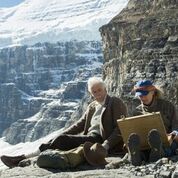 Peter Raymont and Nancy Lang have completed their third documentary celebrating Canada’s revered Group of Seven painters following West Wind: The Vision of Tom Thomson (2011) and Painted Land: In Search of the Group of Seven (2015). The latest chapter, Where the Universe Sings: The Spiritual Journey of Lawren Harris documents the life (October 23, 1885 – J anuary 29, 1970) of the founder and leader of the Group of Seven painters and a pioneer of what is now considered the Canadian landscape art movement. His earliest works, vividly colored scenes and cityscapes of the “Ward 5” slums of Toronto, the stunningly intense natural landscapes of Algoma and the north shore of Lake Superior, t the Rockies, the Arctic and his abstract works from his Santa Fe phase. Colm Feore provides the voice as Harris “narrates” in his own words gleaned from his lett
Peter Raymont and Nancy Lang have completed their third documentary celebrating Canada’s revered Group of Seven painters following West Wind: The Vision of Tom Thomson (2011) and Painted Land: In Search of the Group of Seven (2015). The latest chapter, Where the Universe Sings: The Spiritual Journey of Lawren Harris documents the life (October 23, 1885 – J anuary 29, 1970) of the founder and leader of the Group of Seven painters and a pioneer of what is now considered the Canadian landscape art movement. His earliest works, vividly colored scenes and cityscapes of the “Ward 5” slums of Toronto, the stunningly intense natural landscapes of Algoma and the north shore of Lake Superior, t the Rockies, the Arctic and his abstract works from his Santa Fe phase. Colm Feore provides the voice as Harris “narrates” in his own words gleaned from his lett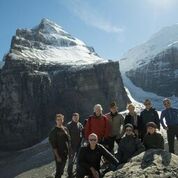 ers, articles and notebooks. We see 130 paintings, family photos and works by artists Harris admired – Van Gogh, Cezanne, Gaugin, Kandinsky, Emily Carr and Georgia O’Keeffe and to some degree informed his work. Archival footage, some that he shot himself, fleshes him out as an iconoclast. He never bowed to the critics and carved his own path through wilderness trails, armed with cavasses and paints, forging a style never seen before in Canada. Experts offer fascinating insights, including actor and collector Steve Martin, the Art Gallery of Ontario’s A ndrew Hunter, the Vancouver Art Gallery’s Ian Thom and Harris’s grandchildren Stew
ers, articles and notebooks. We see 130 paintings, family photos and works by artists Harris admired – Van Gogh, Cezanne, Gaugin, Kandinsky, Emily Carr and Georgia O’Keeffe and to some degree informed his work. Archival footage, some that he shot himself, fleshes him out as an iconoclast. He never bowed to the critics and carved his own path through wilderness trails, armed with cavasses and paints, forging a style never seen before in Canada. Experts offer fascinating insights, including actor and collector Steve Martin, the Art Gallery of Ontario’s A ndrew Hunter, the Vancouver Art Gallery’s Ian Thom and Harris’s grandchildren Stew 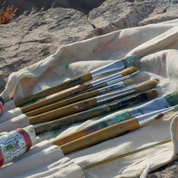 Sheppard and Toni Chowne. We spoke with Nancy Lang about this passion project.
Sheppard and Toni Chowne. We spoke with Nancy Lang about this passion project.
The recent $11M sale of Lawren Harris’ Mountain Forms and the passion of Steve Martin put Harris on the world map. Is it concerning that Harris’ work will be sold privately never to be seen publically again?
No. I don’t know but it very well may be that piece may be given to a gallery. Many of those extraordinary collectors do that, purchase and donate. Steve Martin’s interest gave me my star headliner to draw attention to this very cool dude. He’s honestly a fan geniuses and lover of the work and I think his interest and decisions to curate that sho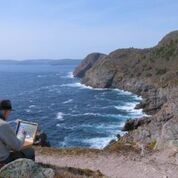 w The Idea of North was extraordinary. It was a wonderful thing. The current Mystical Landscapes exhibit is going to Paris this summer; a Lawren Harris will be hung in the Musée D’Orsay and Fred Varley will hang next to him.
w The Idea of North was extraordinary. It was a wonderful thing. The current Mystical Landscapes exhibit is going to Paris this summer; a Lawren Harris will be hung in the Musée D’Orsay and Fred Varley will hang next to him.
When I was young Group of Seven prints were everywhere – government buildings, banks, anything official. I see them with new eyes now and recognise that they help us define our country. What changed?
Movement and style come and go in the popularity. In the 60s and 70s and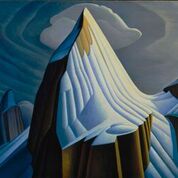 80s Canadian art was becoming more abstract and modern but now there is an interest that could be many years – landscapes. We are all interested in getting out there and protecting what we have. Also there is a sentimental attachment to the Group of Seven and that time period and who they were.
80s Canadian art was becoming more abstract and modern but now there is an interest that could be many years – landscapes. We are all interested in getting out there and protecting what we have. Also there is a sentimental attachment to the Group of Seven and that time period and who they were.
Harris’ commitment to Theosophy appears to have quite literally shaped his later works.
In terms of his colour and the sereneness and spiritual quality of his work – what was so interesting was to dispel that spiritual theosophy that always stays with him. There is an understanding that in every religion there is a common thread, some essence that’s the same we’re just these person on the planet and out there is a more immutable presence something better and above us, Allah, God, Buddha.
Theosophy is about intellect, a proof of religion, and some is quite esoteric. There are those charts and it’s thought of as approach to life. He took it seriously and wrote for the theosophist magazines. This was his interest and he had this ongoing journey and it was represented in his work. Different locations on that journey were more simplified, rarified and there were those experiences while standing before those mountains were meditative.
Someone called an early exhibit a “chamber of horrors”, a 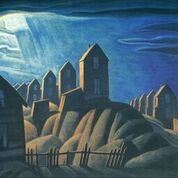 rejection of his vision of nature. Also, he was a radical in wealthy conservative Toronto. Is this why the Group of Seven was formed? To feel belonging?
rejection of his vision of nature. Also, he was a radical in wealthy conservative Toronto. Is this why the Group of Seven was formed? To feel belonging?
Yes so they wouldn’t feel so alone. They supported each other and they had fun with the critics. They really got them going. Harris would present himself to the public formally but privately he was a real jokester. He was animated and funny and deeply cared about the other artists in significant ways. He built the Studio building (Rosedale, Toronto) in 1914 just before the war and it cost a small fortune, but he wanted artists to come and be there and to foster a Canadian school of painting. Harris was an extraordinary man and artist and quite political in his own way.
When he came back to Canada from Santa Fe, he lobbied the National Gallery to have satellite galleries, and was a leader of art groups. He supported Emily Carr, financially and morally and not to give up her work when he was feeling low.
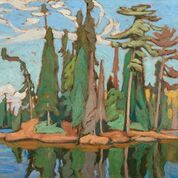 Most of the narration whenever we could we tried to tell the story with Harris’ own words, to get rid of the intermediary. Colm Feore is Harris, the narrator and at least fifty percent of what he read was Harris and Carr’s letters to one another.
Most of the narration whenever we could we tried to tell the story with Harris’ own words, to get rid of the intermediary. Colm Feore is Harris, the narrator and at least fifty percent of what he read was Harris and Carr’s letters to one another.
There have been some films on The Group of Seven. This is the first to my knowledge on Lawren Harris – how did you come to make it?
I did a book on a hotel in Georgian Bay and it got me going. I met with White Pine Pictures who were making short Toronto history trailers and suggested some stories. Peter Raymont had always wanted a film about Tom Thompson.
I made Painted Land: In Search of the Group of Seven which finds the places they painted. It’s online at TVO.org. It’s a crazy story. We were showing West Wind: The Vision of Tom Thomson and I contacted the local art curator. I arrived at his house and saw a slide presentation and said “This will make a film!”
That’s the genesis of the film through Algoma and the history of the Group. It’s a fun film. And now the Harris and Steve Martin Show! I went to TVO on bended knee and ultimately made three films on the Group of Seven.
Next I’d like to do a film on David Milne. When I see the response to the films it makes every bit of sweat and tears worth it. The next three years are going to be exciting. It will be the 100th anniversary of the founding of the Group of Seven.